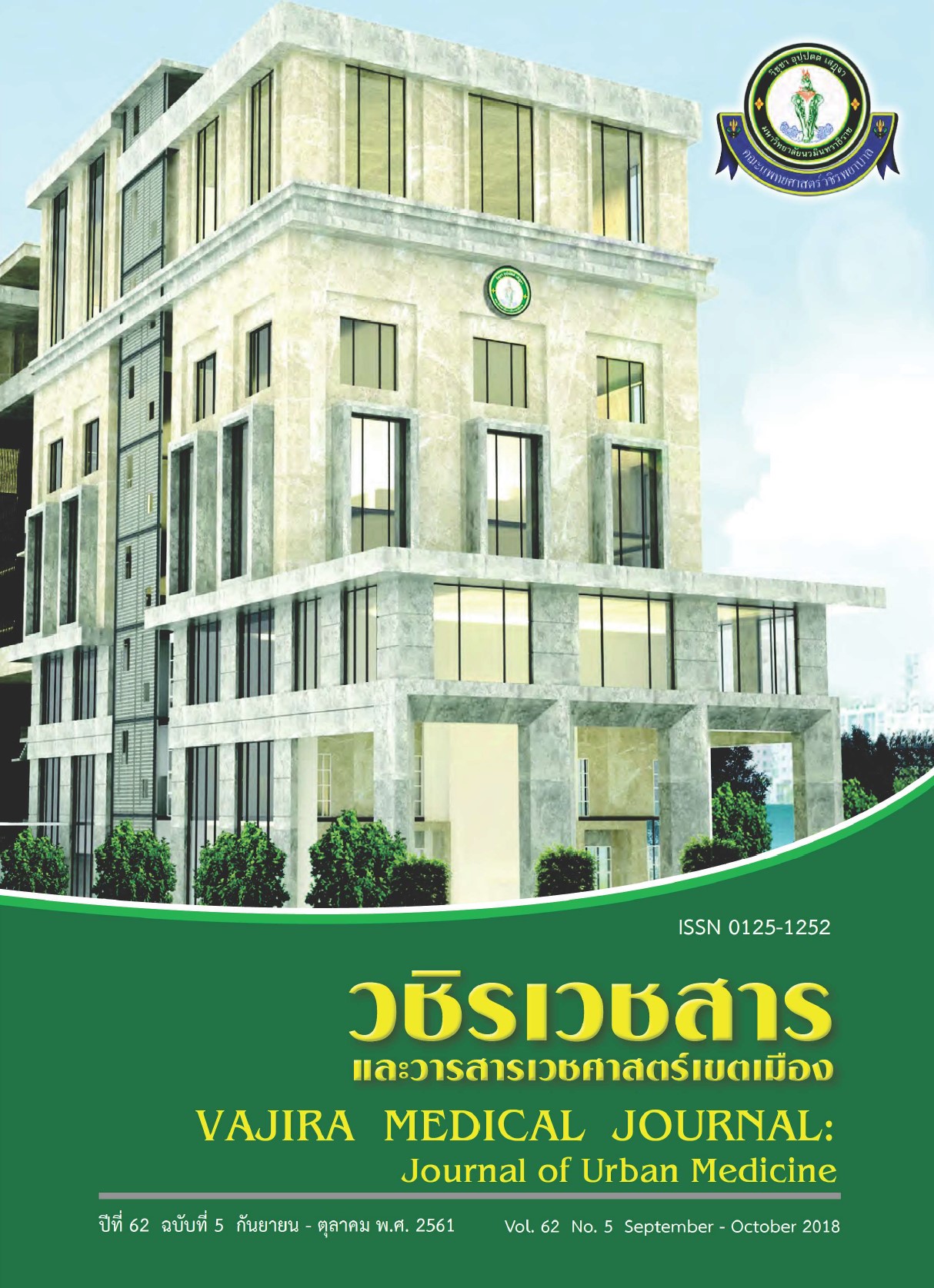Deep Neck Infection in Faculty of Medicine Vajira Hospital, Navamindradhiraj University
Main Article Content
Abstract
Objective: To study demographic characteristics, site of infection, bacteriology, etiology, length of hospital stay, treatment and complications of deep neck infection in Faculty of Medicine Vajira Hospital, Navamindradhiraj University. This was a retrospective descriptive study in patients with deep neck infection during 2009-2016.
Methods: The researchers reviewed data from inpatient records of 131 patients including demographic characteristics, site of infection, bacteriology, etiology, length of hospital stay, treatment and complications. The data were analyzed by descriptive statistics while Chi-square and Independent t-tests were used to compare relationship between DM and non-DM group
Result: 131 patients were included; 51.1% were male. Average age was 47.7 ± 19.7 years old. The most common range of age was 41-50 years old. The most common sites of infection were submandibular space (34.4%), then parotid space (11.5%). There were 10 patients (7.6%) who had more than 1 space infection. The most common cause of infection was odontogenic infection (62.6%). Common pathogens were Streptococcus viridans (12.2%) but in DM group common pathogens were Klebsiella pneumoniae (29.5%). Average length of hospital stay was 7.8 ± 4.7 days. Average length of hospital stay in DM group was longer (9.3 ± 5.4) when compared with non-DM group (7.0 ± 4.0). The 77 patients (58.8%) underwent open surgical drainage. There were 11 patients who needed intubation or tracheostomy (8.4%). The complication rate was about 20.6%. Most common complications were upper airway obstruction (6.9%) then sepsis (3.8%). In DM group, there were 11.4% who had more than 1 complication but in non-DM group there were only 1.1%.
Conclusion: The most common cause of deep neck infection in Faculty of Medicine Vajira Hospital, Navamindradhiraj University was odontogenic infection, where submandibular space was the most common site of infection. Generally, Streptococcus viridans was the most common pathogen but there was a strong correlation with Klebsiella pneumoniae infection in DM group. The study shows that patients in the DM group tended to have more severe clinical course in aspect of length of hospital stay, intubation or tracheostomy and other complications. Early diagnosis and treatment were very important in order to reduce risk of complication.
Downloads
Article Details
References
Poeschl PW, Spusta L, Russmueller G, Seemann R, Hirschl A, Poeschl E, et al. Antibiotic susceptibility and resistance of the odontogenic microbiological spectrum and its clinical impact on severe deep space head and neck infections. Oral Surg Oral Med Oral Pathol Oral Radiol Endod. 2010;110:151-6
ปิยวรรณ คงตังจิตต์. Deep neck infection: comparison of clinical course and outcome between diabetic and non-diabetic patients. วารสาร หู คอ จมูก และ ใบหน้า 2548; 1: 35-51
รัศมี ซิงเถียรตระกูล. Deep neck infection in Bhumibol Adulyadej Hospital [วิทยานิพนธ์แพทยศาสตรมหาบัณฑิต]. กรุงเทพฯ. โรงพยาบาลภูมิพลอดุลยเดช; 2550: p 1-16
ชูเกียรติ วงศ์นิจศีล. Deep neck abscess clinical review at Khonkaen Hospital. ขอนแก่นเวชสาร 2008;32 (2): 147-54
พัชรินทร์ วัชรินทร์ยานนท์. การศึกษาภาวะติดเชื้อของเยือหุ้มชั้นลึกบริเวณคอในโรงพยาบาลอุตรดิตถ์ 2014;1: 32-42
Abshirini H, Alavi SM, Rekabi H, Hosseinnejad F, Ghazinpour A, Shabab M. Predisposing factors for the complications of deep neck infections. Iran J Otorhinolaryngol. 2010; 22: 97-102
Lee JK, Kim HD, Lim SC. Predisposing factors of deep neck infection: An analysis of 158 cases.Yonsei Med J. 2007; 48: 58-62
W Yang. Deep neck infection: A review of 130 cases in South China. South China Med. 2015;94: e994
Chen MK, Wen YS, Chang CC, Lee HS, Huang MT, Hsiao HC. Deep neck infections in diabetic patients. Am J Otolaryngol. 2000; 21 (3): 169-73
Huang TT, Tseng FY, Liu TC, Hsu CJ, Chen YS. Deep neck infection in diabetic patients: comparison of clinical picture and outcomes with nondiabetic patients. Otolaryngol Head Neck Surg. 2005 ;132(6) :943-7
วิชาญ จงประสาธน์สุข. การศึกษาผู้ป่วยติดเชื้อของเยื่อหุ้มชั้นลึกบริเวณคอในโรงพยาบาลน่าน.ลำปางเวชสาร 2554; 37 (2) : 42-50
Roscoe DL, Hoang L. Microbiologic investigations for head and neck infections. Infect Dis Clin N Am. 2007; 21: 283-304
Har-El G, Aroesty JH, Shaha A, Lucent FE. Changing trends in deep neck abscess. Oral Med Oral Pathol. 1994;77: 446-50.
Lin HT, Tsai CS, Chen YL, Liang JG. Influence of diabetes mellitus on deep neck infection. J Laryngol Otol. 2006;120 (8):650-4
Rega AJ, Aziz SR, Ziccardi VB. Microbiology and Antibiotic Sensitivities of Head and Neck Space Infections of Odontogenic Origin. J Oral Maxillofac Surg. 2006; 64:1377-81
Lyudmila B, Rossen K, Galina G, Elitsa D, Jivko M, Milen M, Ivan M. Anaerobic bacteria in 118 patients with deep space head and neck infections from the University Hospital of Maxillofacial Surgery, Sofia, Bulgaria. J of Med Microb. 2006; 55: 1285–9.


